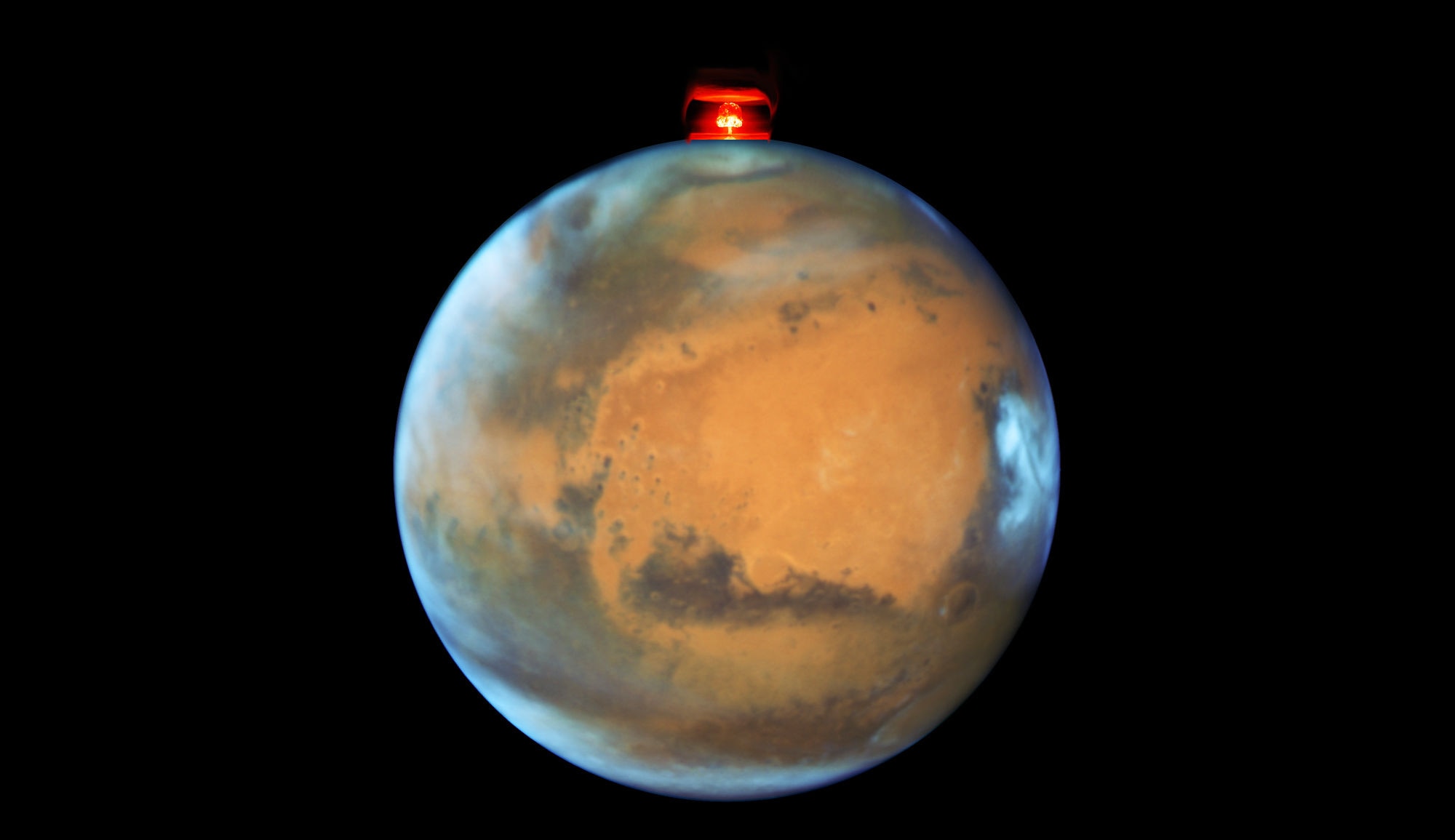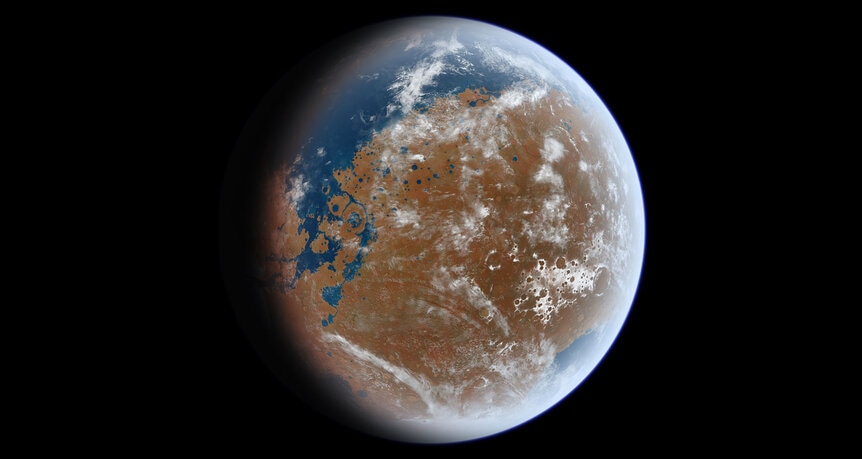Create a free profile to get unlimited access to exclusive videos, sweepstakes, and more!
Is nuking Mars a good idea? (No)

Of all the other planets in the solar system, Mars is the one most like Earth in terms of the ability of humans to live there. Venus is closer in size and mass to Earth, but its ridiculously thick atmosphere of carbon dioxide gives it a surface pressure 90 times Earth’s and a runaway greenhouse effect that would soften and/or melt the metal in a housing structure. Not to mention the sulfuric acid rain.
Not that Mars is hugely better. It has only 0.6% the atmospheric pressure Earth does, so standing on the surface without a pressure suit is the equivalent of trying to breathe 30 kilometers above Earth’s surface — three times higher than jets fly. You’d suffocate before you could freeze to death in the frigid temperatures there.
So it’s not like it’s going to be easy.
But… carbon dioxide is a greenhouse gas. So is water vapor. And Mars has polar ice caps that have both. What if we just thawed out the ice caps? Would that release enough CO2 and H2O to make Mars livable?
It’s an interesting idea. Elon Musk (maybe) thinks so, or that “it’s a step in the right direction”:
… and he followed with several other comments, including:
But, is it really?
I wondered. First, I don’t want to delve into the thick and difficult politics and philosophical ramifications of putting people permanently on Mars; that’s fraught with all sorts of issues that would take a series of articles to discuss, and I don’t want to get into here.
Also, it’s hard to tell when Musk is joking or when he’s serious. But let’s take this at face value. Thinking about this, I wanted to know about the feasibility of liberating all that polar ice, and how to do it. Just to see if it’s even possible.
It didn’t take long to find out… it isn’t. Not realistically, at least. The planetary science of this was handled ably in a paper published just last year in Nature. They investigated how much gas you’d need to add to the atmosphere of Mars such that liquid water could exist on its surface, and where that gas might be found.
They note that although water vapor is a greenhouse gas, it’ll simply freeze right back out of the atmosphere if thawed as things stand. So, there needs to be enough carbon dioxide released into the atmosphere to warm things up enough first before the water can help.
Atmospheric pressure is measured in units called bars, where the atmospheric pressure of Earth at sea level is 1 bar. In metric units, that’s very roughly 1 kilogram of air pressing down on every square centimeter of the Earth.
The current pressure on Mars is 6 millibars, which is about 15 grams of CO2 per square centimeter. To get to 1 bar — the needed pressure to sustain water on the surface — you’d need about 2,500 grams per square centimeter (higher than Earth due to the lower gravity of Mars). Obviously, it’ll take a lot of CO2, over 150 times what’s there now.
And there’s the problem. There isn’t all that much frozen CO2 in the Martian polar caps. The research authors find that if you thaw both caps completely you’ll only add about 9 millibars of pressure to the air there, which is still only 15 millibars. That’s a far cry from the 1,000 millibars needed! Mind you, the layers of dry ice on the caps are thin, just a few meters thick at most, and in the relative summer most of it sublimates (turns into a gas) anyway. Obviously, that’s not really helping, so thawing out both caps at the same time is still just a drop in the bucket.
Nuking the caps, as Musk suggests, won’t really help. The ice caps are hundreds of kilometers across, and it would take huge numbers of detonated weapons to liberate all that CO2 (remembering that thawing the water won’t help; it’ll just refreeze). There’s also the issue of lingering radiation, which would make the poles and probably much more of Mars uninhabitable for centuries.
Smashing comets into the poles is a far better idea, since there’s no radiation, and they’re commonly made up of substantial amounts of frozen water and CO2. Asteroids, too. This might take longer, since moving them around isn’t easy, but there are many ideas on how to do that… and as an added bonus, it would give SpaceX a lot of knowledge on how to move potentially dangerous rocks headed toward Earth.
However, like nukes, it would take a huge number to thaw the polar caps. It also might put a lot of dust into the atmosphere that would cool the planet, not warm it. The sheer number of impacts you’d need to implement this would drastically change the surface of Mars, too.
Speaking of which there’s CO2 and water locked up in minerals and ice just below the surface at mid-latitudes. However, as the authors of the study show, getting that into the atmosphere is essentially impossible with current technology. And even then, it just doesn’t add enough to the air to get anywhere near what you’d need to live, even if you reprocessed the entire surface of the planet down to a depth of 100 meters. That might make finding a place to live afterwards a little difficult. It would also take centuries to accomplish this, at least.
As the authors state, “One could imagine redirecting asteroids to hit Mars and release volatiles, but the global distribution of the gas that is present would require covering Mars with impact craters; again, this is not feasible in practice.”
No matter what, the best we can probably do is triple the pressure on Mars, and that’s still far, far short of what’s needed. Remember, Mars is a planet. A small one, but even a small one is huge. It takes a lot of air to cover it.
[As an aside, Mars once had lots more air, and liquid water on its surface. But that was billions of years ago, and the vast majority of this was lost when, we think, Mars lost its magnetic field. Without that to protect it from the solar wind, the Sun sandblasted Mars until the air and water were almost entirely gone.]
I haven’t even talked about the fact that nuking Mars at all might be illegal; the Outer Space Treaty makes it illegal for nations to detonate nukes in space, including the surface of Mars, and it states that countries are responsible for the actions of private companies in their borders. The legality of this is tricky, but I suspect it would be incredibly difficult to do this… even if Musk had, say, a thousand thermonuclear warheads with which to experiment. I suspect a private company may have a hard time getting their hands on those, and the US wouldn’t be able to help since it’s a signatory to the treaty.
But it doesn’t matter anyway. The conclusion the authors draw is well worth quoting here:
There is not enough CO2 left on Mars in any known, readily accessible reservoir, if mobilized and emplaced into the atmosphere, to produce any significant increase in temperature or pressure. Even if enough CO2 were to be available, it would not be feasible to mobilize it; doing so would require processing a major fraction of the surface (analogous to regional- or planet-scale strip mining) to release it into the atmosphere, which is beyond present-day technology. Terraforming Mars is therefore not possible in the foreseeable future by utilizing CO2 resources available on the planet.
Oof. That’s a lot of sci-fi dreams rudely interrupted. Now, I am not dismissing this idea entirely; perhaps in the future more methods will come to light. But the idea of walking around on Mars with just an oxygen mask may not be feasible for centuries, if ever. Perhaps living in underground lava tubes is still doable, or adapting local conditions like that.
But, as much as I hate to say it (and I do), a globally transformed Mars with lakes and seas and rain and life everywhere… that may yet remain science fiction.



























